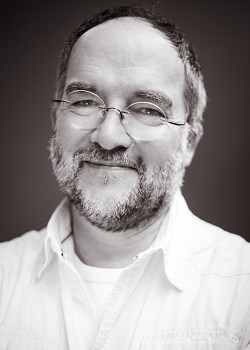Janry

Janry was born on 2 October 1957 in Jadotville, currently Likasi, in Zaire.
The first colours he knows, therefore, are those of Africa. But also those of his father who works in a paint factory, and those of his older brother who makes "wonder drawings" for him whenever his school results are good, which is quite often. All this can only lead to a taste for pictures.
In Brussels, where he goes to live with his parents at the age of 10, this taste soon becomes a passion. Janry draws anytime, anything and anywhere. He particularly loves technical things, such as engines and especially aeroplanes.
In order to develop his talent he is enrolled in a school for graphic arts. This is where he creates his first work with someone who will become his partner and friend: Tome. They start their own studio with a fine team which develops step by step: Stéphane De Becker, Bruno Gazzotti, Christian Darasse...
Janry publishes his first plates in the fanzines. He assists Francis, Dupa, Greg, Turk and De Groot for a while before he gets to illustrate, together with Tome, a games section for SPIROU ("Jeuréka"). This is the time when the editor wishes to revitalise the production of the main character of his weekly magazine.
In order to get out of their routine jobs as assistant painters, the two friends embark on a slightly foolish project: to bring "Spirou et Fantasio" back to life in the spirit of the early adventures they read as children. They work on two pages of "La Voix sans maître" and go to see Franquin who, kind as always, invites them in and gives them a few valuable pieces of advice, without concealing, however, the hazards involved in recreating a character.
To Tome and Janry this is a dream they have to pursue, a challenge to take and an adventure to throw themselves into, body and soul.They divide the work fairly. Tome takes on the hand-drawn script, inks the backgrounds and, sometimes, the sketches, as well as the colour indications. Janry sketches the backgrounds and characters and inks the latter. Their first complete story is received with such enthusiasm that they get full responsibility for "Spirou et Fantasio" in 1981.In 1986, when they start on the episode "Le Réveil du Z" and Stéphane De Becker comes to work in their studio, they review their task distribution.
Tome is responsible for the script from now on, still hand-drawn, while Janry realises the entire graphic part and De Becker takes on the colours.After a short parody depicting the childhood of "Spirou et Fantasio", they create in 1987 "Le Petit Spirou", a lovely mischievous and impertinent boy, surrounded by a rich collection of caricature characters. It's a smashing triumph ...
Within a few years, half a million books about the little bugger are sold! This success encourages them to let Spirou evolve once more, composing an actual modern thriller for him ("Machine qui rêve", 1998), which enables him to set a new course toward the 20th century in his new adventures.
While Tome diversifies in scriptwriting, Janry is also tempted by writing and has designed the pages for "Passe-moi l'Ciel" for Stuf since 1990.
Originally focused on games, this series has developed with true gags of tasty originality. The first books have created a little corner of paradise with infernal fumes in all the good bookshops.
